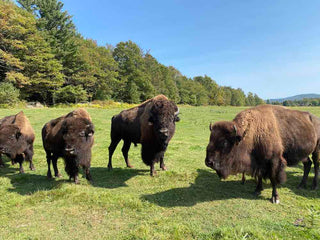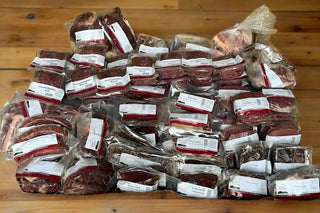National Bison Month: Celebrating Our Iconic Buffalo
Each July we celebrate National Bison Month, a time to honor America’s largest land mammal and its incredible comeback story. In fact, Congress officially named the American bison our national mammal in 2016, and since then conservation groups and parks have marked July as Bison Month. We now have thousands of bison roaming North America, but that wasn’t always true. Two centuries ago there were an estimated 30–60 million bison across the continent, by the late 1800s, fewer than 1,000 remained. Bison Month exists to remind us of that near-extinction and to celebrate the recovery of this species, a story filled with history, culture, and conservation.
Cultural and Historical Significance
For Native American tribes the bison (or “buffalo”) was the center of life. Plains nations called the buffalo their “Brother” and relied on every part of the animal, from meat and hides to bones and sinews, for food, clothing, shelter, and tools. It also held deep spiritual meaning in ceremonies and stories. The mass slaughter of bison in the 1800s devastated these cultures as much as the animals themselves. Market hunters, railroads, and government policy drove the “Great Slaughter,” wiping out millions of bison in just a few decades. By the 1890s only a few hundred bison survived.
Thankfully, early 20th-century conservation efforts, often led by Native and non-Native allies, began turning the tide. In 1905, William Hornaday and President Theodore Roosevelt formed the American Bison Society, sparking America’s first major wildlife recovery. They relocated a few dozen bison into protected areas (like Wind Cave and Wichita Mountains), and Yellowstone and other parks began guarding the last wild herds. Zoos and private herds also played a role. Today about 500,000 bison live on public and private lands across the U.S., and over 30,000 on public preserves. Those millions of grassland acres that once lost their keystone grazer are slowly healing, thanks in large part to those early efforts. The bison’s story, from near extinction to “threatened” status, is truly one of America’s great conservation successes.
Ecological Importance of the Bison
Bison are more than a cultural symbol; they’re ecosystem engineers. As the largest terrestrial mammal in North America, bison historically shaped the prairie environment like no other animal. Millions of roaming bison created a constantly shifting mosaic of grazing and wallowing. Their herd movements helped distribute plant seeds and nutrients – their shaggy coats carried seeds to new places, and insects and microbes broke down their dung to fertilize the soil. When bison “wallow” (rolling in dust or mud), they dig shallow pits that later fill with rain or snowmelt; these tiny ponds become habitat for amphibians, plants, and insects. Over thousands of years, such behaviors maintained healthier, more diverse prairies than you get without them.
Bison are also remarkably adapted to harsh climates. Their massive shoulder hump is made of muscle (unlike cattle, which store fat) so they can swing their head side-to-side to sweep away heavy snow and reach buried grasses. Thick fur and a slow metabolism let them tolerate bitter cold, while in summer they thrive on grasses, sedges, and forbs. Because of their grazing habits, bison encourage new grass growth and help prairies recover from disturbances (even fire). Resilient in droughts and deep winters, bison historically occupied more territory, from Mexico’s grasslands to Alaska, than any other native mammal. In short, healthy bison herds mean healthy grasslands.
Fun Facts About Bison
- Fast and agile: Don’t let the bulk fool you! Bison can sprint at around 30–35 mph, and they’re surprisingly athletic, spinning quickly, leaping over 5–6 foot obstacles, and even swimming well across rivers or lakes.
- "Red dogs": Bison calves are born between late March and May, covered in a reddish-brown fur (earning the nickname “red dogs”). Their coats darken after a few months as they grow.
- Snow plows on hooves: Each winter, a bison uses its massive neck muscles (the hump) to sweep away snow and munch the grass beneath. Their broad hooves and strong bodies make them tougher in snow than deer or elk.
- Huge eaters: A bison may eat 20–25 pounds of grass per day, up to 11 hours of grazing daily. This grazing creates open areas that light up with wildflowers and new grasses.
- Ecosystem engineers: Rolling in dust isn’t just for fun. Bison wallows collect water and seeds, fostering diverse plant patches. Their droppings and fur similarly spread nutrients and seeds across the prairie.
- Long-lived: In the wild, bison can live 15–20 years. Females breed by age 2–3, usually birthing one calf each spring. Bulls typically don’t reproduce until around 6–7 years old, after they’re fully grown.

How to Celebrate and Learn More
There are so many fun ways to celebrate Bison Month and learn about these majestic animals! Here are a few ideas:
- Visit bison herds in the wild or at parks. Head to national parks like Yellowstone (home to about 5,400 free-ranging bison, the largest herd on public land), Wind Cave and Custer State Park in South Dakota, Badlands, Theodore Roosevelt National Park, or the National Bison Range in Montana. Don’t forget to stay 100 feet away from the animals, they’re wild and unpredictable, even while grazing or resting.
- Support bison conservation organizations. Consider donating to or volunteering with groups like the InterTribal Buffalo Council, the National Bison Association, Wildlife Conservation Society, or local wildlife refuges and conservancies. Buying sustainably-raised bison meat or products can also support ranchers who help keep bison on the landscape.
- Attend events or share online. Some parks and zoos host “Buffalo Days” or bison-themed talks in July. Follow hashtags like #NationalBisonMonth or #BuffaloUnited on social media. Share your own photos, stories, or art to raise awareness.
- Read and explore educational resources. The National Park Service and Wildlife Conservation Society have great info on bison history and ecology. Check out documentaries like "Escape From Extinction", or visit local museums with Plains Indian or frontier exhibits. Even kids’ books about bison are a great way to get the whole family involved.
Conservation Milestones and What’s Ahead
The story of the bison’s recovery continues into 2025. In 2020, the U.S. Department of the Interior launched a Bison Conservation Initiative, a 10-year plan to restore wild, free-ranging herds. Since then, major funding and new partnerships have developed. In 2023, the Secretary of the Interior dedicated $25 million to bison restoration on national lands and helped launch a Tribal Bison Shared Stewardship Strategy. In late 2024, the U.S., Canada, and Mexico signed a Trilateral Agreement to coordinate bison conservation across borders.
Today, roughly 31,000 wild bison are stewarded across North America. That includes Yellowstone and dozens of other public and tribal herds. In contrast, about 360,000 bison live on private ranches. Many Native American tribes are bringing buffalo back to ancestral lands – an act of cultural renewal that also strengthens conservation.
Yankee Farmer’s Market is proud to be part of this restoration story. For more than 27 years, we’ve raised and cared for bison here in New Hampshire, offering healthy, pasture-raised meat, supporting public education, and helping new farmers get started through mentorship and our live animal program. Our commitment to sustainability, responsible stewardship, and sharing the bison’s legacy is woven into everything we do.
We’ve come a long way from the brink of extinction. As we celebrate National Bison Month this July, we honor that story, the people who made it possible, and the bison themselves. Visit a herd, support a project, or simply share a photo, as you’re part of this incredible legacy.
References
- National Park Service – Bison Bellows Series
- Wildlife Conservation Society – Bison Recovery Projects
- U.S. Department of the Interior – Bison Conservation Initiative
- InterTribal Buffalo Council – https://itbcbuffalonation.org
- National Bison Association – https://bisoncentral.com
- Yellowstone National Park – Bison Management
- World Wildlife Fund – Bison Facts
- American Humane – Escape From Extinction Documentary



